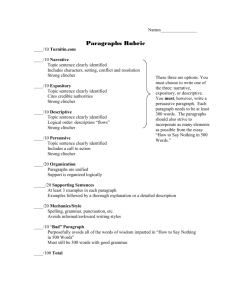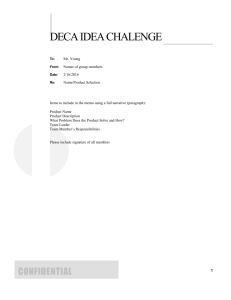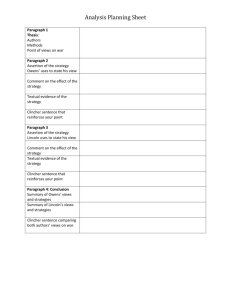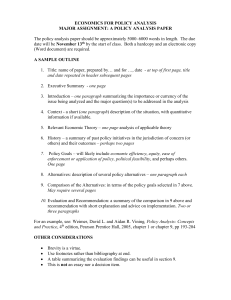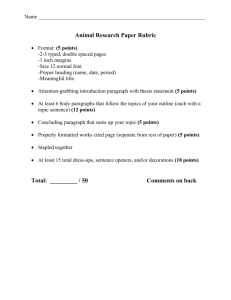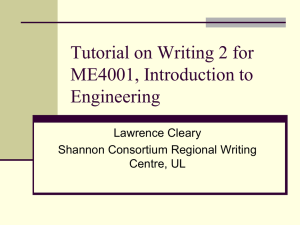Unit III: Summarizing Narrative Stories Once students can
advertisement
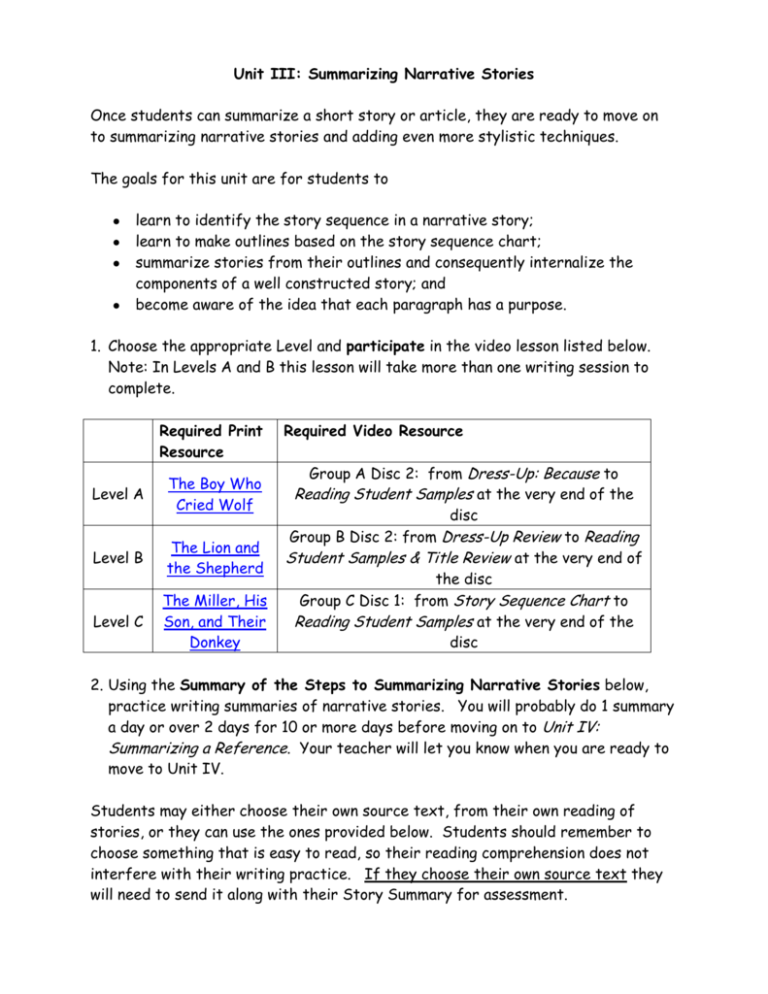
Unit III: Summarizing Narrative Stories Once students can summarize a short story or article, they are ready to move on to summarizing narrative stories and adding even more stylistic techniques. The goals for this unit are for students to learn to identify the story sequence in a narrative story; learn to make outlines based on the story sequence chart; summarize stories from their outlines and consequently internalize the components of a well constructed story; and become aware of the idea that each paragraph has a purpose. 1. Choose the appropriate Level and participate in the video lesson listed below. Note: In Levels A and B this lesson will take more than one writing session to complete. Required Print Resource Level A The Boy Who Cried Wolf Level B The Lion and the Shepherd Level C The Miller, His Son, and Their Donkey Required Video Resource Group A Disc 2: from Dress-Up: Because to Reading Student Samples at the very end of the disc Group B Disc 2: from Dress-Up Review to Reading Student Samples & Title Review at the very end of the disc Group C Disc 1: from Story Sequence Chart to Reading Student Samples at the very end of the disc 2. Using the Summary of the Steps to Summarizing Narrative Stories below, practice writing summaries of narrative stories. You will probably do 1 summary a day or over 2 days for 10 or more days before moving on to Unit IV: Summarizing a Reference. Your teacher will let you know when you are ready to move to Unit IV. Students may either choose their own source text, from their own reading of stories, or they can use the ones provided below. Students should remember to choose something that is easy to read, so their reading comprehension does not interfere with their writing practice. If they choose their own source text they will need to send it along with their Story Summary for assessment. Beginning Reader Felipe No Monsters Under My Bed Marvin the Curious Mouse The Little Frog and The Big Buffalo Level A Aday and the Orphan Aday's Strange Behaviour Aday Shows His Teeth Aday Cools Down At Red Rock Bitsy's Promise Hamilton the Hamster Grandmother's Table Puffer Bunny Level B Level C More Aday Stories: More Aday Stories: Julie Becomes a Toddler Challenged The Mackenzie Street Boy On Guard Mackenzie Gets Bolder Mackenzie's Quest Broo in Nahloo Jack's Jealousy Jeffery the Goose Buck Makes a Move Grandmother's Table Elopement The Fox and the Crow Mourning The Frog Prince The Horse and the Fox The Little Fish Who Swam to the Big Ocean The Fox and the Crow The Tiger and the Lion The Horse and the Fox Bob Feigns Disinterest Julie's Independence The Bat and the Nightingale The Good King's Feast The Mackenzies Are Not Amused Journey of Fear The Queen Bee The Halifax Explosion Summary of the Steps to Summarizing Narrative Stories Step One: Read the story and think about it in terms of the Story Sequence Chart (shown below) Step Two: Create a 3 paragraph key word outline, not choosing words from each sentence, but choosing words that communicate the story sequence. Step Three: Think about different words to describe the characters, different synonyms for various nouns and verbs in the story. Variations on the plot, additional characters or actions are encouraged. This is fiction! Record your ideas on your Story Outline (shown further below) Step Four: Write (or preferably type) your own version of the summaries in 3 paragraphs from the outline based on the story sequence chart. The “final clincher” (last sentence in the story) must repeat words in the title. Set up the heading of your writing, similar to that of your key word outline EXCEPT, this time just underline where the title is going to go, but don’t copy it down. This is because you will eventually create your own title....but it will be the last step of writing your passage. That way you can be sure to choose a title that includes words from your final clincher. Note: You must double space your work, because you will not be allowed to do any erasing if you write, instead of type, your initial draft of your passage. Use a pen. It is okay to make mistakes. o To remove a word, simply draw a single line through the mistake. o To add a word place a carat (^ or v) where you want the word to go and write it in the space above it. o To move a word, draw a circle around the words you want to move and then draw an error from the circle to the place where you want the words to go. Write or type up your final draft for submission to your teacher. (Grade 6+ students are expected to type their work.) Step Five: Identify where you have used the required dress-up(s) Underline 1 place where you used each of the required types of dress-ups in each paragraph. Only underline one of each type per paragraph. If you have more than one, pick the one you like the best. Step Six: Ensure there are no banned words in your composition. If you find them, replace them with stronger words. Step Seven: Verify that you have completed all of the steps above on the appropriate Unit III Checklist – everyone starts at Stage 1 and progresses through to Stage 4, as indicated by your teacher’s comments on your work. The Story Sequence Chart I. II. III. Story Sequence Who is in the story? When does it happen? Where does he live or go? What do they want or need? What do they think? What do they say and do? How was the problem solved? What was learned? Final Clincher repeats title I. II. III. Story Structure Characters Setting Mood Conflict Problem Surprise/Resolution Moral Epilogue Clincher repeats title Original Story Title __________________________________________________________ ________________________________________________ by _____________________________________ I. ________________________________________________________________ 1. __________________________________________________ 2. __________________________________________________ 3. __________________________________________________ 4. __________________________________________________ II. _________________________________________________________________ 1. __________________________________________________ 2. __________________________________________________ 3. __________________________________________________ 4. __________________________________________________ III. _________________________________________________________________ 1. __________________________________________________ 2. __________________________________________________ 3. __________________________________________________ 4. __________________________________________________ Dress-Ups Brainstorming “lys” “who/which” strong verbs because quality adjectives Paragraph 1 Paragraph 2 Paragraph 3
